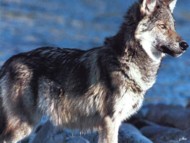 Wolves WolvesWolf History, Conservation, Ecology and Behavior
[www.wolfology.com]
|
Wolfology Item # 121
Source
v150 n4 (October 1997)
Click on the journal title (above) for information on acquiring the complete article
|
 |
Wolf Pack Size and Food Acquisition
Paul A. Schmidt & L. David Mech
1997
|
|
Abstract:
This study contradicts previous findings that indicate wolf packs smaller than optimal size acquire less food per wolf than those of optimal size. Instead, the data presented indicates that there is less food per wolf as pack size increases. The authors propose a kin-selection hypothesis to explain why wolves live in packs.
 Many workers have proposed or accepted the idea that the reason gray wolves (Canis lupus) live in groups, or packs, is because group hunting facilitates their acquisition of large prey (Murie 1944; Mech 1970; Zimen 1976; Nudds 1978; Pullium and Caraco 1978; Bekoff and Wells 1980; Rodman 1981). In other words, a pack of eight wolves, for example, would be more than twice as successful as a pack of four. If this proposal is valid, then the amount of food acquired per individual should increase as pack size increases, at least to some optimal size.
Nudds (1978) utilized sparse data from the literature and detected an apparent relationship between wolf pack size and food acquired per wolf that implied that packs smaller than optimal size acquired substantially less food per wolf than those of optimal size. He also speculated that there were different optimal pack sizes for wolves preying on moose (Alces alces) and other large prey than for those preying principally on deer (Odocoileus virginianus), by analogy to the situation described by Caraco and Wolf (1975) for lions (Panthera leo).
However, Thurber and Peterson (1993) used considerably more data and demonstrated that for wolves preying primarily on moose on Isle Royale, food acquisition per wolf decreased with increased pack size. Hayes (1995) found the same for wolves preying on moose and caribou ((Rangifer tarandus)....Their findings not only contradicted Nudds's (1978) notion of optimal pack size but also tended to refute the claim that wolves live in packs in order to facilitate the killing of larger prey....
Thurber and Peterson's (1993) study involved a single population of wolves and a single prey animal; Hayes's (1995) investigation included two prey species. Here we examine the literature based on wolf populations in many areas and involving several prey species to better evaluate the relationship between wolf pack size and food acquisition and its implications for the optimal pack size hypothesis that wolves live in groups to faciliate killing larger prey.
We examined predation rates from 11 studies completed between 1971 and 1989 involving the following prey species: white-tailed deer, moose, sheep, caribou and bison (Bison bison)....
The pack sizes in our review varied from two to 20 wolves, and the calculated number of kilograms of food acquired per wolf per day ranged from 0.5 to 45.2. The total data set, including wolves that preyed on more than one species, showed a negative curvilinear relationship between pack size and amount of food acquired. We found similar but stronger relationships when the data were examined separately for deer and for moose. No analysis showed an increase in food acquired per wolf with an increase in pack size.
We found no evidence that increased pack size resulted in increased food acquired per wolf. In fact, regardless of how the data were examined -- using all data, using data by prey species, or using data by study area -- the relationship indicated less food per wolf as pack size increased....
We propose a kin-selection hypothesis to explain why wolves live in packs, as Schoener (1971), Rodman (1981), and Hayes (1995) also did, but for a slightly different reason....We believe that wolves live in packs primarily because adult pairs can then efficiently share with their offspring the surplus of food resulting from the pair's predation on large mammals.....
The clearest support for our hypothesis comes from the fact that it is pairs of wolves, rather than, for example, packs of three or four, that acquire more food per wolf than does each member of larger packs on average....By bringing their young with them on hunts, pair invest their energetic profit in their genetic heritage and maximize their energetic efficiency. Until they gain physical maturity and sufficient experience, the young likely obtain more food by remaining with their parents than by hunting on their own. In addition, they gain the hunting and killing experience that will further their survival after dispersal....
|